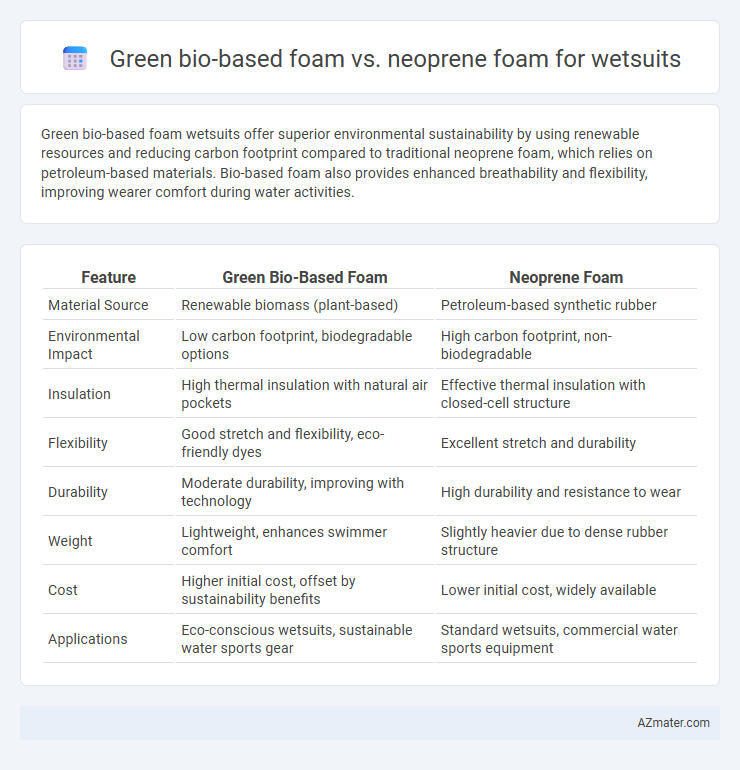Green bio-based foam wetsuits offer superior environmental sustainability by using renewable resources and reducing carbon footprint compared to traditional neoprene foam, which relies on petroleum-based materials. Bio-based foam also provides enhanced breathability and flexibility, improving wearer comfort during water activities.
Table of Comparison
| Feature | Green Bio-Based Foam | Neoprene Foam |
|---|---|---|
| Material Source | Renewable biomass (plant-based) | Petroleum-based synthetic rubber |
| Environmental Impact | Low carbon footprint, biodegradable options | High carbon footprint, non-biodegradable |
| Insulation | High thermal insulation with natural air pockets | Effective thermal insulation with closed-cell structure |
| Flexibility | Good stretch and flexibility, eco-friendly dyes | Excellent stretch and durability |
| Durability | Moderate durability, improving with technology | High durability and resistance to wear |
| Weight | Lightweight, enhances swimmer comfort | Slightly heavier due to dense rubber structure |
| Cost | Higher initial cost, offset by sustainability benefits | Lower initial cost, widely available |
| Applications | Eco-conscious wetsuits, sustainable water sports gear | Standard wetsuits, commercial water sports equipment |
Introduction to Wetsuit Materials
Green bio-based foam for wetsuits offers an eco-friendly alternative by utilizing renewable plant-based materials that reduce environmental impact compared to traditional petroleum-based neoprene foam. Neoprene foam, widely used in wetsuit manufacturing, provides excellent insulation, flexibility, and abrasion resistance but relies on non-renewable resources and releases harmful chemicals during production. The choice between green bio-based foam and neoprene foam directly affects wetsuit performance, sustainability, and consumer preference in the surf and dive industries.
What is Green Bio-Based Foam?
Green bio-based foam is an eco-friendly alternative to traditional neoprene foam, made from renewable biomass sources such as natural rubber, cork, or algae. This sustainable material offers comparable insulation, flexibility, and durability to neoprene while significantly reducing the environmental impact associated with petroleum-based foams. Its biodegradable and non-toxic properties make it a popular choice for eco-conscious wetsuit manufacturers aiming to minimize carbon footprint and marine pollution.
Understanding Neoprene Foam
Neoprene foam is a synthetic rubber widely used in wetsuits for its excellent insulation properties and flexibility in cold water environments. It consists of closed-cell nitrogen gas bubbles that provide buoyancy and thermal resistance, key for maintaining body heat during prolonged water exposure. Understanding neoprene foam's durability, water resistance, and elasticity helps in comparing it to green bio-based foams, which aim to offer more sustainable alternatives without compromising performance.
Environmental Impact: Bio-Based vs Neoprene
Green bio-based foam wetsuits significantly reduce carbon emissions and reliance on petroleum by utilizing renewable plant-derived materials, offering a sustainable alternative to traditional neoprene foam. Neoprene production involves high energy consumption and releases toxic chemicals, contributing to environmental pollution and non-biodegradability issues. Bio-based foams often feature improved biodegradability and lower ecological footprints, aligning with eco-conscious consumer demands for wetsuit materials.
Performance Comparison: Flexibility and Insulation
Green bio-based foam in wetsuits offers superior insulation by trapping heat efficiently while maintaining lightweight properties, enhancing warmth without bulk. Neoprene foam provides excellent flexibility and durability, adapting well to body movements but can be heavier and less eco-friendly. Performance-wise, green bio-based foam excels in thermal retention with comparable flexibility, promoting sustainable comfort for extended water activities.
Comfort and Fit of Bio-Based and Neoprene Wetsuits
Green bio-based foam wetsuits offer superior breathability and flexibility compared to traditional neoprene, enhancing overall comfort and adaptability to body shapes. The bio-based foam's natural elasticity ensures a snug, second-skin fit that reduces water flushing and heat loss. Neoprene foam, while durable and insulating, may feel stiffer and less accommodating, potentially limiting movement and comfort during extended wear.
Durability and Longevity of Wetsuit Foams
Green bio-based foam wetsuits offer enhanced environmental sustainability with comparable durability to neoprene foam, but may exhibit slightly reduced longevity under extreme conditions such as prolonged UV exposure and saltwater immersion. Neoprene foam remains the industry standard for wetsuits due to its superior resistance to wear, tear, and compression over time, ensuring longer-lasting performance in demanding marine environments. Advances in bio-based foam technology are closing the durability gap, providing eco-conscious alternatives without significantly compromising the lifespan of wetsuit materials.
Health and Safety Considerations
Green bio-based foam in wetsuits offers significant health and safety advantages over neoprene foam by reducing exposure to toxic chemicals such as volatile organic compounds (VOCs) and chlorinated compounds commonly found in neoprene production. Its biodegradable and non-toxic properties minimize allergic reactions and environmental pollutants during both manufacturing and disposal phases. Choosing bio-based foam enhances user safety by promoting better skin compatibility and lowering the risk of respiratory irritation or chemical sensitivity associated with traditional neoprene materials.
Cost and Accessibility in the Market
Green bio-based foam for wetsuits offers a sustainable alternative with growing but still limited market availability, often priced higher due to eco-friendly production processes and niche demand. Neoprene foam remains more cost-effective and widely accessible, benefiting from established manufacturing infrastructure and global supply chains. Consumers seeking affordable wetsuits currently find neoprene options more readily available, while green bio-based foam appeals to environmentally conscious buyers willing to invest in premium materials.
Future Trends in Sustainable Wetsuit Materials
Green bio-based foam for wetsuits is emerging as a sustainable alternative to traditional neoprene, offering reduced environmental impact through biodegradable and renewable resources such as algae, natural rubber, and plant-based oils. Innovations in bio-foam production focus on enhancing thermal insulation, flexibility, and durability to match or exceed neoprene's performance while minimizing carbon footprint and chemical pollutants. Future trends emphasize circular economy principles, with increased adoption of recycled materials and closed-loop manufacturing processes to meet growing consumer demand for eco-friendly wetsuit options.

Infographic: Green bio-based foam vs Neoprene foam for Wetsuit
 azmater.com
azmater.com